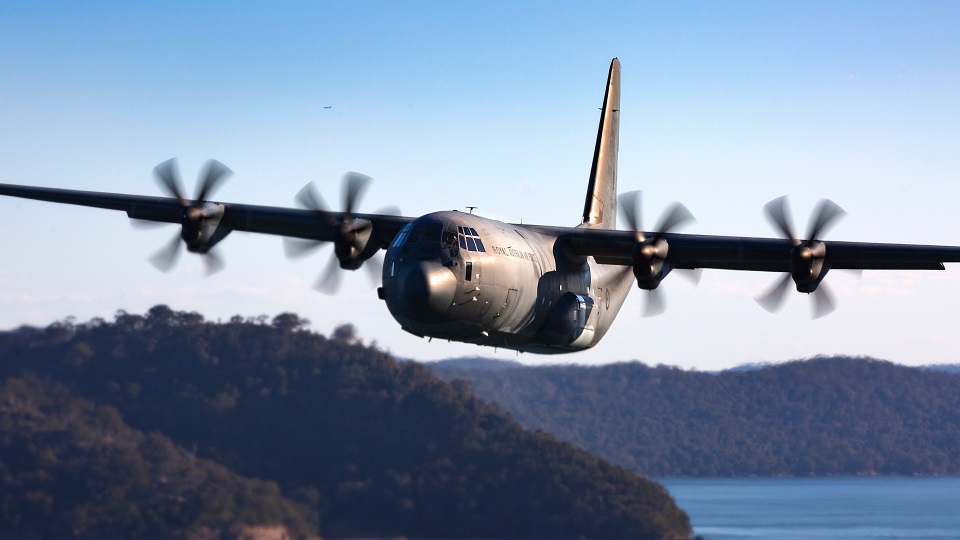
A Royal Australian Air Force C-130J Hercules transport aircraft conducts formation practice on the New South Wales coast near Sydney. (Royal Australian Air Force)
SYDNEY — Australia appears to have committed to buy at least 12 C-130Js from Lockheed Martin for a so-far undisclosed price, in a manner unusual for Canberra.
The announcement came in an unusual press release yesterday from the Department of Defence, not, as would be usual, from either the defense minister or defense industry minster.
“What’s really interesting is, defense (department) always resists saying what advice it provided to government even after a decision has been announced,” Marcus Hellyer, a top defense procurement expert at the government-funded Australian Strategic Policy Institute, said in an interview. “Here, they’re actually announcing what advice they’re going to provide to government before they’ve even gone forward to government, so it’s a very unusual sort of arrangement.
“I don’t know if it’s somehow a sign of greater transparency or why, but normally, defence steadfastly resist saying what options it’s taking up to government,” Hellyer added. “It’s quite unusual that they’re flagging they are only taking one option to government before they’ve actually even done it.”
The press release says that the Department of Defense “has approached a number of aircraft manufacturers and received information on all available medium air mobility options. The relative merits of each aircraft type have been assessed against Australia’s capability requirements.”
But Hellyer notes that no tenders have been issued and this announcement seems to indicate that the department has acted before a minister has approved the decision. It may be that this is a declaration simply that the requirement could not be met by any other competitor, therefore the department has decided to recommend buying these.
“Defence has identified that the new C-130J aircraft represents the only option that meets all of Australia’s capability requirements and assures Defence’s medium air mobility capability without introducing substantial cost, schedule and capability risk,” the release says. “As a result, new C-130J aircraft will be the only option that Defence will progress for Government approval under Project AIR 7404 Phase 1 in 2023.”
Even if this is only a recommendation to the Labor government, given that there are no competitors, it is effectively a decision to buy the Lockheed planes.
In addition to the unusual nature of the announcement, Australia’s defense budget plan, known as Force Structure Plan 2020, allocates up to $13.2 billion AUD to replace its existing 12 C-130J-30 aircraft, but funding was not expected to begin until 2029, just before the existing fleet reaches the end of its life.
Hellyer says it’s not clear whether this announcement means the funding will be pulled forward or not.
The size of the purchase is likely to be substantially larger than simply a replacement of the existing fleet, since Australia’s fleet of 10 C-27s will now only be used in non-combat situations, suggesting that more C-130Js will be needed to fill the gap, Hellyer said.
“We’ve sort of lost a chunk of what was meant to be a battlefield capability so you can make the argument the new C-130 fleet needs to fill that gap,” Hellyer said. Also, there’s the underlying strategic situation. “Every strategic warning indicator says our strategic circumstances are degenerating and we need more capability.”
Another reason for more C-130s is that Australia was recently approved by the US State Department to buy 20 units of HIMARS, the much vaunted mobile artillery system. The C-130 can carry HIMARS, as can the C-17. Australia demonstrated last year an advanced version of shoot and scoot for HIMARS, using advanced targeting systems on board the C-17 to feed data to the artillery system. When the C-17 landed, HIMARS demonstrated the ability to roll off on landing, fire, destroy the targets and roll back on the plane, which could take off before being targeted. Presumably, the new C-130s could accomplish something similar. All that argues for more C-130s to deliver the new capability.
The selection of the C-130 in and of itself isn’t terribly surprising, given that Australia already owns the planes, knows how to fly and maintain them and has shown a marked predilection for American weapons. Also, the A-400M, while an excellent capability, is French; buying it or Embraer’s jet-powered C-390 Millennium would raise all sorts of new supply chain questions and require retraining Australia’s pilots, not an inexpensive endeavor.
There had been discussion of Australia buying at least some KC-130Js so the planes could serve as airborne tankers refuelers, but there’s no mention of that in the release.






















